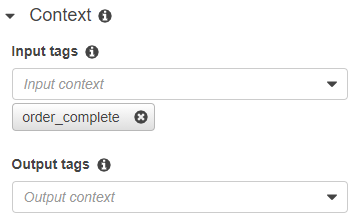End of support notice: On September 15, 2025, AWS will discontinue support for Amazon Lex V1. After September 15, 2025, you will no longer be able to access the Amazon Lex V1 console or Amazon Lex V1 resources. If you are using Amazon Lex V2, refer to the Amazon Lex V2 guide instead. .
Setting Intent Context
You can have Amazon Lex trigger intents based on context. A context is a state variable that can be associated with an intent when you define a bot.
You configure the contexts for an intent when you create the
intent using the console or using the PutIntent operation. You can only use
contexts in the English (US) (en-US) locale, and only if you
set the enableModelImprovements parameter to
true when you created the bot with the PutBot operation.
There are two types of relationships for contexts, output contexts and input contexts. An output context becomes active when an associated intent is fulfilled. An output context is returned to your application in the response from the PostText or PostContent operation, and it is set for the current session. After a context is activated, it stays active for the number of turns or time limit configured when the context was defined.
An input context specifies conditions under which an intent can be recognized. An intent can only be recognized during a conversation when all of its input contexts are active. An intent with no input contexts is always eligible for recognition.
Amazon Lex automatically manages the lifecycle of contexts that are
activated by fulfilling intents with output contexts. You can also
set active contexts in a call to the PostContent or
PostText operation.
You can also set the context of a conversation using the Lambda function for the intent. The output context from Amazon Lex is sent to the Lambda function input event. The Lambda function can send contexts in its response. For more information, see Lambda Function Input Event and Response Format.
For example, suppose you have an intent to book a rental car that is configured to return an output context called "book_car_fulfilled". When the intent is fulfilled, Amazon Lex sets the output context variable "book_car_fulfilled". Since "book_car_fulfilled" is an active context, an intent with the "book_car_fulfilled" context set as an input context is now considered for recognition, as long as a user utterance is recognized as an attempt to elicit that intent. You can use this for intents that only make sense after booking a car, such as emailing a receipt or modifying a reservation.
Output Context
Amazon Lex makes an intent's output contexts active when the intent is fulfilled. You can use the output context to control the intents eligible to follow up the current intent.
Each context has a list of parameters that are maintained in the session. The parameters are the slot values for the fulfilled intent. You can use these parameters to pre-populate slot values for other intents. For more information,see Using Default Slot Values.
You configure the output context when you create an intent with the console or with the PutIntent operation. You can configure an intent with more than one output context. When the intent is fulfilled, all of the output contexts are activated and returned in the PostText or PostContent response.
The following shows assigning an output context to an intent using the console.

When you define an output context you also define its time to live, the length of time or number of turns that the context is included in responses from Amazon Lex. A turn is one request from your application to Amazon Lex. Once the number of turns or the time has expired, the context is no longer active.
Your application can use the output context as needed. For example, your application can use the output context to:
-
Change the behavior of the application based on the context. For example, a travel application could have a different action for the context "book_car_fulfilled" than "rental_hotel_fulfilled."
-
Return the output context to Amazon Lex as the input context for the next utterance. If Amazon Lex recognizes the utterance as an attempt to elicit an intent, it uses the context to limit the intents that can be returned to ones with the specified context.
Input Context
You set an input context to limit the points in the conversation where the intent is recognized. Intents without an input context are always eligible to be recognized.
You set the input contexts that an intent responds to using
the console or the PutIntent operation. An intent
can have more than one input context. The following shows
assigning an input context to an intent using the
console.

For an intent with more than one input context, all contexts must be active to trigger the intent. You can set an input context when you call the PostText, PostContent, or PutSession operation.
You can configure the slots in an intent to take default values from the current
active context. Default values are used when Amazon Lex recognizes a new intent but
doesn't receive a slot value. You specify the context name and slot name in the form
#context-name.parameter-name when you define the slot. For more
information, see Using Default Slot
Values.